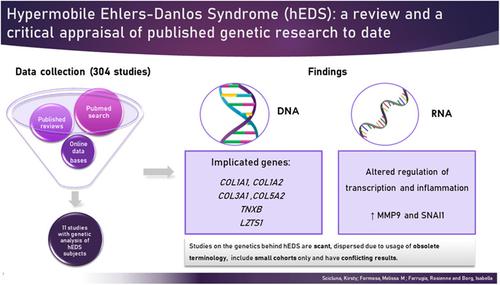当前位置:
X-MOL 学术
›
Clin. Genet.
›
论文详情
Our official English website, www.x-mol.net, welcomes your feedback! (Note: you will need to create a separate account there.)
Hypermobile Ehlers–Danlos syndrome: A review and a critical appraisal of published genetic research to date
Clinical Genetics ( IF 3.5 ) Pub Date : 2021-07-04 , DOI: 10.1111/cge.14026 Kirsty Scicluna 1 , Melissa M Formosa 1, 2 , Rosienne Farrugia 1, 2 , Isabella Borg 2, 3, 4
Clinical Genetics ( IF 3.5 ) Pub Date : 2021-07-04 , DOI: 10.1111/cge.14026 Kirsty Scicluna 1 , Melissa M Formosa 1, 2 , Rosienne Farrugia 1, 2 , Isabella Borg 2, 3, 4
Affiliation

|
The Ehlers–Danlos syndromes (EDS) are a collection of rare hereditary connective tissue disorders with heterogeneous phenotypes, usually diagnosed following clinical examination and confirmatory genetic testing. Diagnosis of the commonest subtype, hypermobile Ehlers–Danlos Syndrome (hEDS), relies solely on a clinical diagnosis since its molecular aetiology remains unknown. We performed an up-to-date literature search and selected 11 out of 304 publications according to a set of established criteria. Studies reporting variants affecting collagen proteins were found to be hindered by cohort misclassification and subsequent lack of reproducibility of these genetic findings. The role of the described variants affecting Tenascin-X and LZTS1 is yet to be demonstrated in the majority of hEDS cases, while the functional implication of associated signaling pathways and genes requires further elucidation. The available literature on the genetics of hEDS is scant, dispersed and conflicting due to out-dated nosology terminology. Recent literature has suggested the role of several promising candidate mechanisms which may be linked to the underlying molecular aetiology. Knowledge of the molecular genetic basis of hEDS is expected to increase in the near future through the mainstream use of high-throughput sequencing combined with the updated classification of EDS, and the upcoming Hypermobile Ehlers–Danlos Genetic Evaluation (HEDGE) study.
中文翻译:

Hypermobile Ehlers-Danlos 综合征:对迄今为止已发表的基因研究的回顾和批判性评估
Ehlers-Danlos 综合征 (EDS) 是一组罕见的具有异质表型的遗传性结缔组织疾病,通常在临床检查和确认性基因检测后诊断。最常见的亚型超活动性埃勒斯-当洛斯综合征 (hEDS) 的诊断仅依赖于临床诊断,因为其分子病因仍然未知。我们进行了最新的文献检索,并根据一套既定标准从 304 篇出版物中选择了 11 篇。报告发现影响胶原蛋白的变异的研究受到队列错误分类和随后缺乏这些遗传发现的可重复性的阻碍。所描述的影响 Tenascin-X 和 LZTS1 的变体的作用尚未在大多数 hEDS 病例中得到证实,而相关信号通路和基因的功能含义需要进一步阐明。由于疾病分类学术语过时,有关 hEDS 遗传学的现有文献很少、分散且相互矛盾。最近的文献提出了几种有希望的候选机制的作用,这些机制可能与潜在的分子病因学有关。通过高通量测序的主流使用以及 EDS 的更新分类以及即将进行的 Hypermobile Ehlers-Danlos 遗传评估 (HEDGE) 研究,预计在不久的将来,人们对 hEDS 分子遗传基础的了解将会增加。最近的文献提出了几种有希望的候选机制的作用,这些机制可能与潜在的分子病因学有关。通过高通量测序的主流使用以及 EDS 的更新分类以及即将进行的 Hypermobile Ehlers-Danlos 遗传评估 (HEDGE) 研究,预计在不久的将来,人们对 hEDS 分子遗传基础的了解将会增加。最近的文献提出了几种有希望的候选机制的作用,这些机制可能与潜在的分子病因学有关。通过高通量测序的主流使用以及 EDS 的更新分类以及即将进行的 Hypermobile Ehlers-Danlos 遗传评估 (HEDGE) 研究,预计在不久的将来,人们对 hEDS 分子遗传基础的了解将会增加。
更新日期:2021-07-04
中文翻译:

Hypermobile Ehlers-Danlos 综合征:对迄今为止已发表的基因研究的回顾和批判性评估
Ehlers-Danlos 综合征 (EDS) 是一组罕见的具有异质表型的遗传性结缔组织疾病,通常在临床检查和确认性基因检测后诊断。最常见的亚型超活动性埃勒斯-当洛斯综合征 (hEDS) 的诊断仅依赖于临床诊断,因为其分子病因仍然未知。我们进行了最新的文献检索,并根据一套既定标准从 304 篇出版物中选择了 11 篇。报告发现影响胶原蛋白的变异的研究受到队列错误分类和随后缺乏这些遗传发现的可重复性的阻碍。所描述的影响 Tenascin-X 和 LZTS1 的变体的作用尚未在大多数 hEDS 病例中得到证实,而相关信号通路和基因的功能含义需要进一步阐明。由于疾病分类学术语过时,有关 hEDS 遗传学的现有文献很少、分散且相互矛盾。最近的文献提出了几种有希望的候选机制的作用,这些机制可能与潜在的分子病因学有关。通过高通量测序的主流使用以及 EDS 的更新分类以及即将进行的 Hypermobile Ehlers-Danlos 遗传评估 (HEDGE) 研究,预计在不久的将来,人们对 hEDS 分子遗传基础的了解将会增加。最近的文献提出了几种有希望的候选机制的作用,这些机制可能与潜在的分子病因学有关。通过高通量测序的主流使用以及 EDS 的更新分类以及即将进行的 Hypermobile Ehlers-Danlos 遗传评估 (HEDGE) 研究,预计在不久的将来,人们对 hEDS 分子遗传基础的了解将会增加。最近的文献提出了几种有希望的候选机制的作用,这些机制可能与潜在的分子病因学有关。通过高通量测序的主流使用以及 EDS 的更新分类以及即将进行的 Hypermobile Ehlers-Danlos 遗传评估 (HEDGE) 研究,预计在不久的将来,人们对 hEDS 分子遗传基础的了解将会增加。



























 京公网安备 11010802027423号
京公网安备 11010802027423号